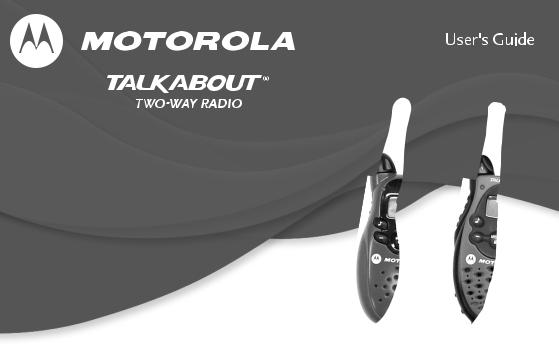Motorola T5600, T5700, T5710, T5720 User Manual

@6881042B60@
6881042B60-A |
Models T5600, T5620, T5700, T5710, T5720 |

Introduction
Congratulations on your purchase of a Motorola product!
Product registration is an important step. Registering helps us facilitate warranty service and permits us to contact you should your Motorola product require an update or other service.
To register your product on-line, visit www.motorola.com/warranty/radios.
Please retain your original dated sales receipt for your records. For warranty service of your Motorola product, you will need to provide a copy of your dated sales receipt to confirm warranty status. Registration is not required for warranty coverage.
For a copy of a large-print version of this guide, or for product-related questions, call:
1-800-353-2729 in the USA
1-888-390-6456 TTY (Text Telephone)
On the web, please refer to www.motorola.com/talkabout
<![endif]>Introduction
1

<![endif]>Contents
Contents
Introduction . . . . . . . . . . . . . . . . . . . . . 1
Safety and General Information . . . . 3
FCC Licensing Information . . . . . . . 11
Control Buttons - Models T5600,
T5700 . . . . . . . . . . . . . . . . . . . . . . . . 12
Control Buttons - Models T5620,
T5710, T5720 . . . . . . . . . . . . . . . . . 13
Getting Started . . . . . . . . . . . . . . . . . 14
Installing the AA Batteries . . . . . . . . . . .14
Installing the NiCd Battery Pack . . . . . .14
Battery Meter . . . . . . . . . . . . . . . . . . . .15
Using the Desk Stand Charger
(Optional Accessory) . . . . . . . . . . . .15
Attaching the Belt Clip . . . . . . . . . . . . . .17
Removing the Belt Clip . . . . . . . . . . . . .17
Turning Your Radio On and Off . . . . . .17
Setting the Volume . . . . . . . . . . . . . . . .17
Setting a Channel . . . . . . . . . . . . . . . . .18
Channels and Frequencies . . . . . . . . . .19
Talking and Listening . . . . . . . . . . . . 20
Talk Range . . . . . . . . . . . . . . . . . . . . . .20
Checking the Channel Before
Transmitting . . . . . . . . . . . . . . . . . . .20
Special Features . . . . . . . . . . . . . . . . .21
Interference Eliminator Code . . . . . . . . 21 Push to Talk Timeout Timer . . . . . . . . . 21 Locking the Keypad . . . . . . . . . . . . . . . 22 Scanning Channels (Models T5620,
T5700, T5710 Only) . . . . . . . . . . . . . 22 Scan Advance . . . . . . . . . . . . . . . . . . . 23 Removing Channels from the Scan List
(Nuisance Delete Feature) . . . . . . . . 23
Alerts . . . . . . . . . . . . . . . . . . . . . . . . . .24
Channel Busy Indicator . . . . . . . . . . . . 24 Setting and Transmitting Call Tones . . 24 Transmitting a Talk Confirmation Tone 25 QT Noise Filtering (Models T5700,
T5710, T5720 Only) . . . . . . . . . . . . . 25
Accessories . . . . . . . . . . . . . . . . . . . .27
Using Audio Accessories . . . . . . . . . . . 27 Voice Activation (VOX) Accessories
(Models T5710, T5720 Only) . . . . . . 27 Setting the Sensitivity Level
(Models T5710, T5720 Only) . . . . . . 28
Patent Information . . . . . . . . . . . . . . .29 Export Law Assurances . . . . . . . . . .29
2

Safety and General Information
Important Information on Safe and Efficient Operation Read This Information Before Using Your Radio
The information provided in this document supersedes the general safety information contained in user guides published prior to July 2000.
Transmit and Receive Procedure
Your two-way radio contains a transmitter and a receiver. To control your exposure and ensure compliance with the general population/uncontrolled environment exposure limits, always adhere to the following procedure:
•Transmit no more than 50% of the time.
•To transmit (talk), press the Push to Talk (PTT) button.
•To receive calls, release the PTT button.
Transmitting 50% of the time, or less, is important because the radio generates measurable RF energy exposure only when transmitting (in terms of measuring standards compliance).
Exposure to Radio Frequency Energy
Your Motorola radio is designed to comply with the following national and international standards and guidelines regarding exposure of human beings to radio frequency electromagnetic energy:
•United States Federal Communications Commission, Code of Federal Regulations; 47 CFR part 2 sub-part J
<![endif]>Safety and General Information
3

<![endif]>Safety and General Information
•American National Standards Institute (ANSI)/Institute of Electrical and Electronic Engineers (IEEE) C95. 1-1992
•Institute of Electrical and Electronic Engineers (IEEE) C95.1-1999 Edition
•International Commission on Non-Ionizing Radiation Protection (ICNIRP) 1998
•Ministry of Health (Canada) Safety Code 6. Limits of Human Exposure to Radio Frequency Electromagnetic Fields in the Frequency Range from 3 kHz to
300 GHz, 1999
•Australian Communications Authority Radiocommunications (Electromagnetic Radiation - Human Exposure) Standard 2001 (applicable to wireless phones only)
•ANATEL, Brasil Regulatory Authority, Resolution 256 (April 11, 2002) “additional requirements for SMR, cellular, and PCS product certification.”
To assure optimal radio performance and make sure human exposure to radio frequency electromagnetic energy is within the guidelines set forth in the above standards, always adhere to the following procedures.
Portable Radio Operation and EME Exposure
Antenna Care
Use only the supplied or an approved replacement antenna. Unauthorized antennas, modifications, or attachments could damage the radio and may violate FCC regulations.
DO NOT hold the antenna when the radio is “IN USE.” Holding the antenna affects the effective range.
4

Two-Way Radio Operation
When using your radio as a traditional two-way radio, hold the radio in a vertical position with the microphone one to two inches (2.5 to 5 cm) away from the lips.
Body-Worn Operation
To maintain compliance with FCC/Health Canada RF exposure guidelines, if you wear a radio on your body when transmitting, always place the radio in a Motorola-supplied or approved clip, holder, holster, case, or body harness for this product. Use of non- Motorola-approved accessories may exceed FCC/Health Canada RF exposure guidelines. If you do not use one of the Motorola-supplied or approved body-worn accessories, and are not using the radio held in the normal use position, ensure the radio and its antenna are at least one inch (2.5 cm) from your body when transmitting.
Data Operation
If applicable, when using any data feature of the radio with or without an accessory cable, position the radio and its antenna at least one inch (2.5 cm) from the body.
Approved Accessories
For a list of approved Motorola accessories visit our website at www.mot.com.
Electromagnetic Interference/Compatibility
Note: Nearly every electronic device is susceptible to electromagnetic interference (EMI) if inadequately shielded, designed, or otherwise configured for electromagnetic compatibility.
<![endif]>Safety and General Information
5

<![endif]>Safety and General Information
Facilities
To avoid electromagnetic interference and/or compatibility conflicts, turn off your radio in any facility where posted notices instruct you to do so. Hospitals or health care facilities may be using equipment that is sensitive to external RF energy.
Aircraft
When instructed to do so, turn off your radio when on board an aircraft. Any use of a radio must be in accordance with applicable regulations per airline crew instructions.
Medical Devices - Pacemakers
The Advanced Medical Technology Association recommends that a minimum separation of six inches (15 cm) be maintained between a handheld wireless radio and a pacemaker. These recommendations are consistent with the independent research by, and recommendations of the U.S. Food and Drug Administration.
Persons with pacemakers should:
•ALWAYS keep the radio more than six inches (15 cm) from their pacemaker when the radio is turned ON.
•Not carry the radio in the breast pocket.
•Use the ear opposite the pacemaker to minimize the potential for interference.
•Turn the radio OFF immediately if you have any reason to suspect that interference is taking place.
6

Medical Devices - Hearing Aids
Some digital wireless radios may interfere with some hearing aids. In the event of such interference, you may want to consult your hearing aid manufacturer to discuss alternatives.
Other Medical Devices
If you use any other personal medical device, consult the manufacturer of your device to determine if it is adequately shielded from RF energy. Your physician may be able to assist you in obtaining this information.
Safety and General Use While Driving
Check the laws and regulations on the use of radios in the area where you drive. Always obey them. When using your radio while driving, please:
•Give full attention to driving and to the road.
•Use hands-free operation, if available.
•Pull off the road and park before making or answering a call if driving conditions so require.
Operational Warnings
For Vehicles with an Air Bag
Do not place a portable radio in the area over an air bag or in the air bag deployment area. Air bags inflate with great force. If a portable radio is placed in the air bag deployment area and the air bag inflates, the radio may be propelled with great force and cause serious injury to occupants of the vehicle.
<![endif]>Safety and General Information
7

<![endif]>Safety and General Information
Potentially Explosive Atmospheres
Turn off your radio prior to entering any area with a potentially explosive atmosphere, unless it is a radio type especially qualified for use in such areas as “Intrinsically Safe.” Do not remove, install, or charge batteries in such areas. Sparks in a potentially explosive atmosphere can cause an explosion or fire resulting in bodily injury or even death.
Note: The areas with potentially explosive atmospheres referred to above include fueling areas such as below decks on boats, fuel or chemical transfer or storage facilities, areas where the air contains chemicals or particles, such as grain, dust or metal powders, and any other area where you would normally be advised to turn off your vehicle engine. Areas with potentially explosive atmospheres are often but not always posted.
Blasting Caps and Areas
To avoid possible interference with blasting operations, turn off your radio when you are near electrical blasting caps, in a blasting area, or in areas posted: “Turn off twoway radio.” Obey all signs and instructions.
Operational Cautions
Antennas
Do not use any portable radio that has a damaged antenna. If a damaged antenna comes into contact with your skin, a minor burn can result.
8
